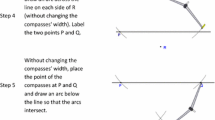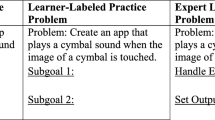Abstract
In order to facilitate the transition fromlearning from worked examples in earlier stagesof skill acquisition to problem solving inlater stages, it is effective to successivelyfade out worked solution steps – in comparisonto the traditional method of employingexample-problem pairs that is frequently usedin cognitive-load research. In the presentstudies, the learning processes and mechanismsthat occur when learning in a computer-basedlearning environment containing faded workedsolution steps were examined across twoexperiments. The first experiment showed thatthe position of the faded steps did notinfluence learning outcomes; instead,individuals learned most about those principlesthat were faded. This suggested that specificself-explanation activities are triggered byfaded steps. The second experiment investigatedthis hypothesis directly by collecting andanalyzing thinking-aloud protocols generated bythe learners during their interaction with thelearning environment. No effect on productivelearning events including self-explanationscould be found. It could, however, be shownthat fading is associated with fewerunproductive learning events and, thereby,lends itself to better learning outcomes.
Similar content being viewed by others
REFERENCES
Atkinson, R.K., Derry, S.J., Renkl, A. & Wortham, D.W. (2000) Learning from examples: Instructional principles from the worked examples research, Review of Educational Research 70: 181–214.
Atkinson, R.K., Renkl, A. & Merrill, M.M. (in press) Transitioning from studying examples to solving problems: Effects of self-explanation prompts and fading, Journal of Educational Psychology.
Catrambone, R. & Holyoak, K.J. (1989) Overcoming contextual limitations on problemsolving transfer, Journal of Experimental Psychology: Learning, Memory, and Cognition 15: 1147–1156.
Chi, M.T.H., Bassok, M., Lewis, M.W., Reimann, P. & Glaser, R. (1989) Self-explanations: How students study and use examples in learning to solve problems, Cognitive Science 13: 145–182.
Ericsson, K.A. & Simon, H.A. (1993) Protocol Analysis. Verbal Reports as Data (revised edition). Cambridge, MA: MIT Press.
Fleischman, E.S. & Jones, R.M. (2002) Why example fading works: A qualitative analysis using Cascade, Proceedings of the 24th Annual Conference of the Cognitive Science Society, pp. 298–303. Mahwah, NJ: Erlbaum.
Fleiss, J.L. (1981) Statistical Methods for Rates and Proportions. New York, NY: Wiley.
Gick, M.L. & Holyoak, K.J. (1983) Schema induction and analogical transfer, Cognitive Psychology 15: 1–38.
Hausmann, R.G.M. & Chi, M.T.H. (2002) Can a computer interface support self-explaining? Cognitive Technology 7: 4–14.
Jones, R.M. & Fleischman, E.S. (2001) CASCADE explains and informs the utility of fading examples to problems, Proceedings of the 23rd Annual Conference of the Cognitive Science Society, pp. 459–464. Mahwah, NJ: Erlbaum.
Kalyuga, S., Ayres, P., Chandler, P. & Sweller, J. (2003) The expertise reversal effect, Educational Psychologist 38: 23–32.
Kalyuga, S., Chandler, P., Tuovinen, J. & Sweller, J. (2001) When problem solving is superior to studying worked examples, Journal of Educational Psychology 93: 579–588.
Kintsch, W. (1986) Learning from text, Cognition and Instruction 3: 87–108.
Renkl, A. (1997) Learning from worked-out examples: A study on individual differences, Cognitive Science 21: 1–29.
Renkl, A. & Atkinson, R.K. (2003) Structuring the transition from example study to problem solving in cognitive skills acquisition: A cognitive load perspective, Educational Psychologist 38: 15–22.
Renkl, A., Atkinson, R.K., Maier, U.H. & Staley, R. (2002) From example study to problem solving: Smooth transitions help learning, Journal of Experimental Education 70: 293–315.
Renkl, A., Gruber, H., Weber, S., Lerche, T. & Schweizer, K. (2003) Cognitive Load beim Lernen aus Lösungsbeispielen [Cognitive load during learning from worked-out examples], Zeitschrift für Pädagogische Psychologie 17: 93–101.
Renkl, A., Stark, R., Gruber, H. & Mandl, H. (1998) Learning from worked-out examples: The effects of example variability and elicited self-explanations, Contemporary Educational Psychology 23: 90–108.
Sweller, J. & Cooper, G.A. (1985) The use of worked examples as a substitute for problem solving in learning algebra, Cognition and Instruction 2: 59–89.
Sweller, J., van Merriënboer, J.J.G. & Paas, F.G. (1998) Cognitive architecture and instructional design, Educational Psychology Review 10: 251–296.
VanLehn, K. (1996) Cognitive skill acquisition, Annual Review of Psychology 47: 513–539.
VanLehn, K. (1998) Analogy events: How examples are used during problem solving, Cognitive Science 22: 347–388.
VanLehn, K. (1999) Rule-learning events in the acquisition of a complex skill: An evaluation of CASCADE, The Journal of the Learning Sciences 8: 71–125.
VanLehn, K. & Jones, R.M. (1993) Learning by explaining examples to oneself: A computational model. In: S. Chipman & A.L. Meyrowitz (eds), Foundations of Knowledge Acquisition: Cognitive Models of Complex Learning, pp. 25–82. Kluwer Academic Pulishing: Boston, MA.
VanLehn, K., Jones, R.M. & Chi, M.T. (1992) A model of the self-explanation effect, The Journal of the Learning Sciences 2: 1–59.
Van Merriënboer, J.J.G. (1990) Strategies for programming instruction in high school: Program completion vs. program generation, Journal of Educational Computing Research 6: 265–287.
Van Merriënboer, J.J.G., Kirschner, P. & Kester, L. (2003) Taking the load off a learner's mind: Instructional design for complex learning, Educational Psychologist 38: 5–13.
Author information
Authors and Affiliations
Corresponding author
Rights and permissions
About this article
Cite this article
Renkl, A., Atkinson, R.K. & Große, C.S. How Fading Worked Solution Steps Works – A Cognitive Load Perspective. Instructional Science 32, 59–82 (2004). https://doi.org/10.1023/B:TRUC.0000021815.74806.f6
Issue Date:
DOI: https://doi.org/10.1023/B:TRUC.0000021815.74806.f6




